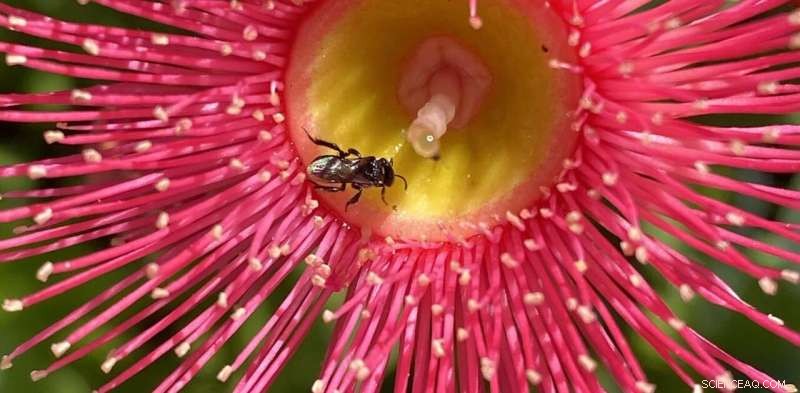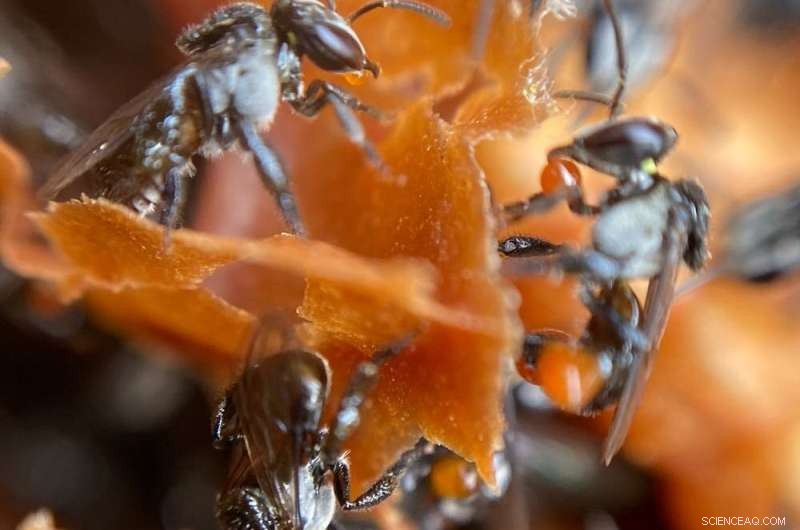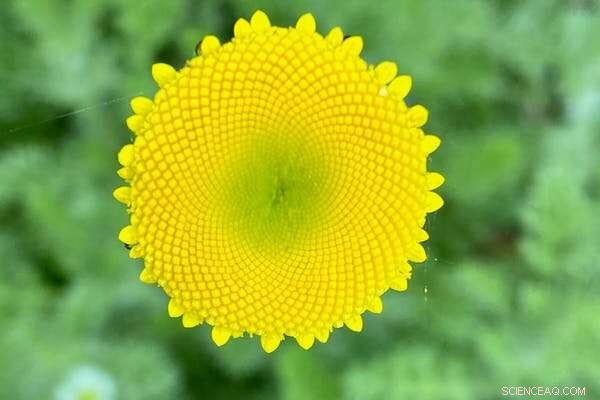
Crédito:Judy Friedlander, proporcionada por la autora
La taxonomía fue una vez el dominio de científicos de bata blanca con años de formación universitaria. Si bien esta experiencia sigue siendo importante, todos los días los australianos ayudan cada vez más a identificar especies a través de aplicaciones de ciencia ciudadana. Los rápidos avances en las cámaras de los teléfonos inteligentes y las tabletas están ayudando a popularizar esta actividad.
Los investigadores de biodiversidad hacen un llamado a los científicos ciudadanos para que contribuyan con datos para llenar los vacíos de información, identificar la disminución de especies e informar las decisiones de gestión. Y los investigadores jóvenes, algunos tan jóvenes como niños en edad preescolar, están dando un paso al frente para ayudar.
Historias como la experiencia de Luke Downey, de 14 años, de Canberra, inspiran a otros a registrar y cargar imágenes en bases de datos de biodiversidad. A principios de este año, Luke encontró un escarabajo raro, Castiarina testacea , visto por última vez en el ACT en 1955. Su observación se registró en el Mapa Natural de Canberra, un depósito en línea de plantas y animales raros.
Adolescente encuentra un raro escarabajo joya en LBG 65 años después del primer avistamiento de ACT https://t.co/EqPT0P9I5O a través de @canberratimes
— Dramatis Scientificae (@DramSci) 11 de enero de 2021
Le puse una lente macro a mi smartphone y me enganché
Mi propia inspiración para convertirme en un científico ciudadano fue una lente macro económica que ahora está fijada permanentemente a mi teléfono inteligente. Este pequeño objetivo portátil fotografía sujetos pequeños a distancias muy cercanas. (Algunos teléfonos inteligentes más nuevos tienen lentes integrados que pueden hacer esto).
Atrapé el "bicho" de tomar imágenes detalladas de primer plano, como la siguiente, de abejas nativas sin aguijón, Tetragonula carbonaria , comunicándose unos con otros y admirando, o cuidando, su cera de abejas. Compartir las imágenes que he tomado ha convertido a otros a este tipo de ciencia ciudadana.

Al conectar una lente macro a su teléfono inteligente (algunos tienen cámaras de primeros planos incorporadas), puede tomar fotos como esta de la abeja nativa sin aguijón, Tetragonula carbonaria. Crédito:Judy Friedlander, proporcionada por la autora
Ahora cualquiera puede tomar primeros planos de insectos, plantas y otras especies para contribuir a las bases de datos de ciencia ciudadana. La claridad de estas imágenes significa que los expertos a menudo pueden determinar la especie, lo que se suma a la comprensión de la distribución y los números para ayudar a la conservación en el terreno.
Actividades como estas aparecen en el programa B&B Highway, a cargo de PlantingSeeds Projects. El programa alienta a los estudiantes de escuelas de Nueva Gales del Sur y Victoria a participar en un proyecto de ciencia ciudadana. Está afiliado a la red y base de datos de biodiversidad internacional iNaturalist y al Atlas of Living Australia de CSIRO.
Los estudiantes están utilizando teléfonos inteligentes y tabletas en los patios de las escuelas para capturar imágenes extraordinarias de insectos de menos de 1 cm de largo o pequeños detalles de partes de flores. Hay un tablero en línea donde los estudiantes pueden ver y compartir observaciones y conocimientos. These images then contribute to our knowledge of species distributions and densities.
Focusing on pollinators
The B&B Highway program has developed a biodiversity-based curriculum with the NSW Department of Education. The project includes plantings and constructed habitats at schools to form regenerative corridors. It has a target of over 60 hubs by mid-2022 to help counter the alarming decline in pollinators in Australia and around the world.
The B&B Highway program provides training for teachers and students. While students are often more at ease with smart devices and their camera functions than their teachers, separate instructions are given to school administrators to set up an iNaturalist account and upload observations. Having a school account ensures students' identities are protected and all observations are listed as the schools."
Children under the age of 13 cannot create an account or engage directly with many citizen science communities, including iNaturalist. This means an adult needs to upload observations.

The photos you take can help fill the gaps in knowledge about the distribution and abundance of pollinators and the flowers they visit. Credit:Judy Friedlander, Author provided
An observation is regarded as research grade if at least two site users agree on the identification to the taxonomic species level. Observations on iNaturalist are shared with the Atlas of Living Australia.
Taxonomists regularly report concern at the lack of data on the distributions and densities of insect pollinators. This month's addition of 124 Australian species to the International Union for Conservation of Nature's (IUCN) Red List of Threatened Species means urgent strategies—including citizen science—are needed to help regeneration.
Urban observations are important as about 30% of Australia's threatened species occur in cities. Yet only about 5% of citizen science projects in Australia are urban-based. With three-quarters of Australia's 23.4 million people now living in a capital city, the citizen science potential is enormous.
Some tips from the experts
The following tips drawn from the iNaturalist teacher's guide will help you get started.
Take identifiable photos. Try to fill the frame with your subject. It may help to use your hand to hold a flower or plant still, but make sure the plant is not dangerous.
Take multiple photos. Many organisms, particularly plants and insects, cannot be identified to species level from a single photo. Take several photos from different angles. For plants, photos of flowers, fruit and leaves are all helpful for ID.

Observations of wild species, like this King Parrot, Alisterus scapularis, are of more scientific value. Credit:Author provided
Focus on wild organisms. In general, the iNat community is more interested in wild organisms. Members respond more to pictures of weeds and bugs than cultivated roses and hamsters in cages.
Pay attention to metadata. This is the information associated with a photo that captures when and where (if location services are on) a photo was taken. Screen shots of photos will lose this data, which may result in incorrect data entry. Watch for locations and dates that don't make sense. If your device's time and date settings are wrong, the data will be wrong.
Don't feel pressured to make research grade observations . Many organisms cannot be identified to the species level using only photographic evidence so observations of them may never attain research grade.
Be aware of copyright. Images should not be copied from books or the internet to illustrate what you observed. Post only your own photos.
Check out Seek. Seek is an educational tool built on iNaturalist. It does not actually post observations to iNaturalist but provides tools such as automated species identification (when possible) and nature journalling.